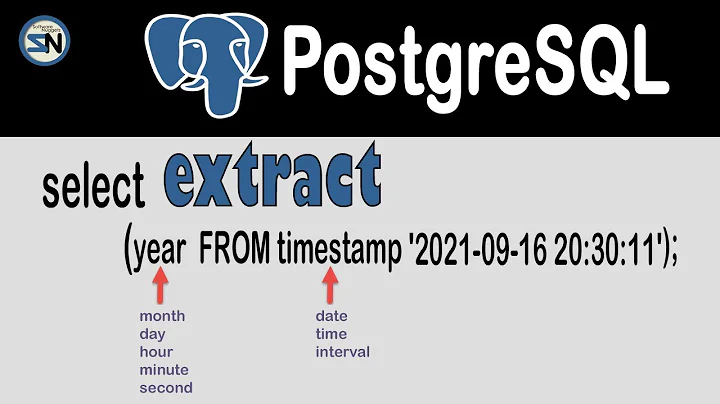Get execution time of PostgreSQL query
Solution 1
There are various ways to measure execution time, each has pros and cons. But whatever you do, some degree of the observer effect applies. I.e., measuring itself may distort the result.
1. EXPLAIN ANALYZE
You can prepend EXPLAIN ANALYZE, which reports the whole query plan with estimated costs actually measured times. The query is actually executed (with all side -effect, if any!). Works for all DDL commands and some others. See:
To check whether my adapted version of your query is, in fact, faster:
EXPLAIN ANALYZE
SELECT DISTINCT born_on.name
FROM born_on b
WHERE date '2012-01-30' - b.dob <= (
SELECT max(d1.dod - b1.dob)
FROM born_on b1
JOIN died_on d1 USING (name) -- name must be unique!
)
AND NOT EXISTS (
SELECT FROM died_on d2
WHERE d2.name = b.name
);
Execute a couple of times to get more comparable times with warm cache. Several options are available to adjust the level of detail.
While mainly interested in total execution time, make it:
EXPLAIN (ANALYZE, COSTS OFF, TIMING OFF)
Mostly, TIMING matters - the manual:
TIMINGInclude actual startup time and time spent in each node in the output. The overhead of repeatedly reading the system clock can slow down the query significantly on some systems, so it may be useful to set this parameter to
FALSEwhen only actual row counts, and not exact times, are needed. Run time of the entire statement is always measured, even when node-level timing is turned off with this option. [...]
EXPLAIN ANALYZE measures on the server, using server time from the server OS, excluding network latency. But EXPLAIN adds some overhead to also output the query plan.
2. psql with \timing
Or use \timing in psql. Like Peter demonstrates.
\timing [ on | off ]With a parameter, turns displaying of how long each SQL statement takes on or off. Without a parameter, toggles the display between on and off. The display is in milliseconds; intervals longer than 1 second are also shown in minutes:seconds format, with hours and days fields added if needed.
Important difference: psql measures on the client using local time from the local OS, so the time includes network latency. This can be a negligible difference or huge depending on connection and volume of returned data.
3. Enable log_duration
This has probably the least overhead per measurement and produces the least distorted timings. But it's a little heavy-handed as you have to be superuser, have to adjust the server configuration, cannot just target the execution of a single query, and you have to read the server logs (unless you redirect to stdout).
log_duration(boolean)Causes the duration of every completed statement to be logged. The default is
off. Only superusers can change this setting.For clients using extended query protocol, durations of the Parse, Bind, and Execute steps are logged independently.
There are related settings like log_min_duration_statement.
4. Precise manual measurement with clock_timestamp()
clock_timestamp()returns the actual current time, and therefore its value changes even within a single SQL command.
filiprem provided a great way to get execution times for ad-hoc queries as exact as possible. On modern hardware, timing overhead should be insignificant but depending on the host OS it can vary wildly. Find out with the server application pg_test_timing.
Else you can mostly filter the overhead like this:
DO
$do$
DECLARE
_timing1 timestamptz;
_start_ts timestamptz;
_end_ts timestamptz;
_overhead numeric; -- in ms
_timing numeric; -- in ms
BEGIN
_timing1 := clock_timestamp();
_start_ts := clock_timestamp();
_end_ts := clock_timestamp();
-- take minimum duration as conservative estimate
_overhead := 1000 * extract(epoch FROM LEAST(_start_ts - _timing1
, _end_ts - _start_ts));
_start_ts := clock_timestamp();
PERFORM 1; -- your query here, replacing the outer SELECT with PERFORM
_end_ts := clock_timestamp();
-- RAISE NOTICE 'Timing overhead in ms = %', _overhead;
RAISE NOTICE 'Execution time in ms = %' , 1000 * (extract(epoch FROM _end_ts - _start_ts)) - _overhead;
END
$do$;
Take the time repeatedly (doing the bare minimum with 3 timestamps here) and pick the minimum interval as conservative estimate for timing overhead. Also, executing the function clock_timestamp() a couple of times should warm it up (in case that matters for your OS).
After measuring the execution time of the payload query, subtract that estimated overhead to get closer to the actual time.
Of course, it's more meaningful for cheap queries to loop 100000 times or execute it on a table with 100000 rows if you can, to make distracting noise insignificant.
Solution 2
If you mean in psql, rather than some program you are writing, use \? for the help, and see:
\timing [on|off] toggle timing of commands (currently off)
And then you get output like:
# \timing on
Timing is on.
# select 1234;
?column?
----------
1234
(1 row)
Time: 0.203 ms
Solution 3
PostgreSQL is not Transact-SQL. These are two slightly different things.
In PostgreSQL, this would be something along the lines of
DO $proc$
DECLARE
StartTime timestamptz;
EndTime timestamptz;
Delta double precision;
BEGIN
StartTime := clock_timestamp();
PERFORM foo FROM bar; /* Put your query here, replacing SELECT with PERFORM */
EndTime := clock_timestamp();
Delta := 1000 * ( extract(epoch from EndTime) - extract(epoch from StartTime) );
RAISE NOTICE 'Duration in millisecs=%', Delta;
END;
$proc$;
On the other hand, measuring query time does not have to be this complicated. There are better ways:
In postgres command line client there is a
\timingfeature which measures query time on client side (similar to duration in bottomright corner of SQL Server Management Studio).It's possible to record query duration in server log (for every query, or only when it lasted longer than X milliseconds).
-
It's possible to collect server-side timing for any single statement using the
EXPLAINcommand:EXPLAIN (ANALYZE, BUFFERS) YOUR QUERY HERE;
Related videos on Youtube
Erwin Brandstetter
Database expert. Warmongers make peace before asking questions.
Updated on March 24, 2022Comments
-
Erwin Brandstetter about 2 years
DECLARE @StartTime datetime,@EndTime datetime SELECT @StartTime=GETDATE() select distinct born_on.name from born_on,died_on where (FLOOR(('2012-01-30'-born_on.DOB)/365.25) <= ( select max(FLOOR((died_on.DOD - born_on.DOB)/365.25)) from died_on, born_on where (died_on.name=born_on.name)) ) and (born_on.name <> All(select name from died_on)) SELECT @EndTime=GETDATE() SELECT DATEDIFF(ms,@StartTime,@EndTime) AS [Duration in millisecs]I am unable to get the query time. Instead I get the following error:
sql:/home/an/Desktop/dbms/query.sql:9: ERROR: syntax error at or near "@" LINE 1: DECLARE @StartTime datetime,@EndTime datetime-
Paul Bain over 12 yearsI tested this query on my SQL studio, just replacing your
select distinct...with something in my DB and it worked fine. What are you using to execute this query? -
 Admin over 12 yearsm running the above query in postgres !! :-/
Admin over 12 yearsm running the above query in postgres !! :-/ -
 pcalcao over 12 yearsWhat exactly are you trying to do? This doesn't seem at all related with Java or JDBC (and from your comment, not even MySql). Is this a stored procedure?
pcalcao over 12 yearsWhat exactly are you trying to do? This doesn't seem at all related with Java or JDBC (and from your comment, not even MySql). Is this a stored procedure? -
 Admin over 12 yearsyes, this is a stored procedure .. data has already been loaded in my DB using JDBC .. now m running the query and wish to know the execution time !!
Admin over 12 yearsyes, this is a stored procedure .. data has already been loaded in my DB using JDBC .. now m running the query and wish to know the execution time !! -
 MatBailie over 12 yearsWhy is this flagged both MySQL and PostgreSQL?
MatBailie over 12 yearsWhy is this flagged both MySQL and PostgreSQL? -
 Admin over 12 years@PaulBain what did u replace "select distinct" with ?
Admin over 12 years@PaulBain what did u replace "select distinct" with ? -
 Admin over 12 yearsit has been flagged so because I am using postgresql.
Admin over 12 yearsit has been flagged so because I am using postgresql. -
 MatBailie over 12 yearsMySQL and PostgreSQL are very different things (As if comparing Teradata to Oracle to Access). If you are using PostgreSQL then you should remove the MySLQ flag :)
MatBailie over 12 yearsMySQL and PostgreSQL are very different things (As if comparing Teradata to Oracle to Access). If you are using PostgreSQL then you should remove the MySLQ flag :) -
 a_horse_with_no_name over 12 years@zyxwvu: so why did you include the MySQL tag in a question that is for PostgreSQL but uses Microsoft SQL syntax? The error message you get is a MySQL Error, not a PostgreSQL error.
a_horse_with_no_name over 12 years@zyxwvu: so why did you include the MySQL tag in a question that is for PostgreSQL but uses Microsoft SQL syntax? The error message you get is a MySQL Error, not a PostgreSQL error.
-
-
Nour Wolf about 9 yearsfor mentioning \timing
-
 Daniel Convissor about 8 yearsThanks for giving the simple, underlying answer to the title of this question.
Daniel Convissor about 8 yearsThanks for giving the simple, underlying answer to the title of this question. -
 Master Chief about 8 yearsI this is the most direct and easiest way to show timing in postgres. Thanks!
Master Chief about 8 yearsI this is the most direct and easiest way to show timing in postgres. Thanks! -
 Jonathan Jacobson about 6 years@filiperm Best define
Jonathan Jacobson about 6 years@filiperm Best defineDeltaasdouble precision -
 Crouching Kitten over 3 yearsThis shows the server side time or the client side (latency)? The docs say nothing about this.
Crouching Kitten over 3 yearsThis shows the server side time or the client side (latency)? The docs say nothing about this. -
Peter over 3 years@CrouchingKitten I tested with a really slow internet, and got "0.261 ms" using the local unix domain socket connection, and "944.272 ms" :D with the slow internet with psql over TCP. So therefore it can only be client side.
-
Erwin Brandstetter about 3 years@CrouchingKitten: Client side - as opposed to total execution time reported by
EXPLAIN ANALYZE, which measures on the server (without network latency). -
 Vérace almost 3 yearsNice (+1) - v. thorough as usual. I think that what you call the
Vérace almost 3 yearsNice (+1) - v. thorough as usual. I think that what you call the"measurement problemmight be better termed theobserver effect? -
Erwin Brandstetter almost 3 years@Vérace: Yes, thank you, that's clearly the better term.
-
JosephDoggie over 2 yearsVery good answer, and it works.





